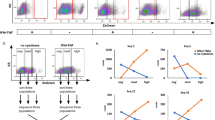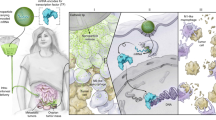Abstract
The nuclear factor-κB (NF-κB) is known to be activated in many cancer types including lung, ovarian, astrocytomas, melanoma, prostate as well as glioblastoma, and has been shown to correlate with disease progression. We have cloned a novel NF-κB-based reporter system (five tandem repeats of NF-κB responsive genomic element (NF; 14 bp each)) to drive the expression cassette for both a fusion between the yeast cytosine deaminase and uracil phosphoribosyltransferase (CU) as a therapeutic gene and the secreted Gaussia luciferase (Gluc) as a blood reporter, separated by an internal ribosomal entry site (NF-CU-IGluc). We showed that malignant tumor cells have high expression of Gluc, which correlates to high activation of NF-κB. When NF-κB was further activated by tumor necrosis factor-α in these cells, we observed up to 10-fold increase in Gluc levels and therefore transgene expression in human glioma cells served to greatly enhance the sensitization of these cells to the prodrug, 5-fluorocytosine both in cultured cells and in vivo subcutaneous tumor xenograft model. This inducible system provides a tool to enhance the expression of imaging and therapeutic genes for cancer therapy.
This is a preview of subscription content, access via your institution
Access options
Subscribe to this journal
Receive 12 print issues and online access
$259.00 per year
only $21.58 per issue
Buy this article
- Purchase on Springer Link
- Instant access to full article PDF
Prices may be subject to local taxes which are calculated during checkout



Similar content being viewed by others
References
Gu J, Kagawa S, Takakura M, Kyo S, Inoue M, Roth JA et al. Tumor-specific transgene expression from the human telomerase reverse transcriptase promoter enables targeting of the therapeutic effects of the Bax gene to cancers. Cancer Res 2000; 60: 5359–5364.
Lidor YJ, Lee WE, Nilson JH, Maxwell IH, Su LJ, Brand E et al. In vitro expression of the diphtheria toxin A-chain gene under the control of human chorionic gonadotropin gene promoters as a means of directing toxicity to ovarian cancer cell lines. Am J Obstet Gynecol 1997; 177: 579–585.
Mueller H . Tumor necrosis factor as an antineoplastic agent: pitfalls and promises. Cell Mol Life Sci 1998; 54: 1291–1298.
King GD, Curtin JF, Candolfi M, Kroeger K, Lowenstein PR, Castro MG . Gene therapy and targeted toxins for glioma. Curr Gene Ther 2005; 5: 535–557.
Both GW . Recent progress in gene-directed enzyme prodrug therapy: an emerging cancer treatment. Curr Opin Mol Ther 2009; 11: 421–432.
Connors TA . The choice of prodrugs for gene directed enzyme prodrug therapy of cancer. Gene Therapy 1995; 2: 702–709.
Denny WA . Prodrugs for gene-directed enzyme-prodrug therapy (suicide Gene therapy). J Biomed Biotechnol 2003; 2003: 48–70.
Khatri A, Russell PJ . Targeted, gene-directed enzyme prodrug therapies to tackle diversity and aggression of late stage prostate cancer. Discov Med 2007; 7: 39–45.
Moolten FL, Wells JM, Heyman RA, Evans RM . Lymphoma regression induced by ganciclovir in mice bearing a herpes thymidine kinase transgene. Hum Gene Ther 1990; 1: 125–134.
Dilber MS, Abedi MR, Christensson B, Bjorkstrand B, Kidder GM, Naus CC et al. Gap junctions promote the bystander effect of herpes simplex virus thymidine kinase in vivo. Cancer Res 1997; 57: 1523–1528.
Mesnil M, Piccoli C, Tiraby G, Willecke K, Yamasaki H . Bystander killing of cancer cells by herpes simplex virus thymidine kinase gene is mediated by connexins. Proc Natl Acad Sci USA 1996; 93: 1831–1835.
Hirschowitz EA, Ohwada A, Pascal WR, Russi TJ, Crystal RG . In vivo adenovirus-mediated gene transfer of the Escherichia coli cytosine deaminase gene to human colon carcinoma-derived tumors induces chemosensitivity to 5-fluorocytosine. Hum Gene Ther 1995; 6: 1055–1063.
Mullen CA, Kilstrup M, Blaese RM . Transfer of the bacterial gene for cytosine deaminase to mammalian cells confers lethal sensitivity to 5-fluorocytosine: a negative selection system. Proc Natl Acad Sci USA 1992; 89: 33–37.
Rowley S, Lindauer M, Gebert JF, Haberkorn U, Oberdorfer F, Moebius U et al. Cytosine deaminase gene as a potential tool for the genetic therapy of colorectal cancer. J Surg Oncol 1996; 61: 42–48.
Gusella M, Frigo AC, Bolzonella C, Marinelli R, Barile C, Bononi A et al. Predictors of survival and toxicity in patients on adjuvant therapy with 5-fluorouracil for colorectal cancer. Br J Cancer 2009; 100: 1549–1557.
Andersen PS, Smith JM, Mygind B . Characterization of the upp gene encoding uracil phosphoribosyltransferase of Escherichia coli K12. Eur J Biochem 1992; 204: 51–56.
Adachi Y, Tamiya T, Ichikawa T, Terada K, Ono Y, Matsumoto K et al. Experimental gene therapy for brain tumors using adenovirus-mediated transfer of cytosine deaminase gene and uracil phosphoribosyltransferase gene with 5-fluorocytosine. Hum Gene Ther 2000; 11: 77–89.
Hamstra DA, Rice DJ, Fahmy S, Ross BD, Rehemtulla A . Enzyme/prodrug therapy for head and neck cancer using a catalytically superior cytosine deaminase. Hum Gene Ther 1999; 10: 1993–2003.
Kievit E, Bershad E, Ng E, Sethna P, Dev I, Lawrence TS et al. Superiority of yeast over bacterial cytosine deaminase for enzyme/prodrug gene therapy in colon cancer xenografts. Cancer Res 1999; 59: 1417–1421.
Baud V, Karin M . Is NF-kappaB a good target for cancer therapy? Hopes and pitfalls. Nat Rev Drug Discov 2009; 8: 33–40.
Pikarsky E, Porat RM, Stein I, Abramovitch R, Amit S, Kasem S et al. NF-kappaB functions as a tumour promoter in inflammation-associated cancer. Nature 2004; 431: 461–466.
Karin M, Greten FR . NF-kappaB: linking inflammation and immunity to cancer development and progression. Nat Rev Immunol 2005; 5: 749–759.
Brach MA, Hass R, Sherman ML, Gunji H, Weichselbaum R, Kufe D . Ionizing radiation induces expression and binding activity of the nuclear factor kappa B. J Clin Invest 1991; 88: 691–695.
Greenberg H, Ye X, Wilson D, Htoo AK, Hendersen T, Liu SF . Chronic intermittent hypoxia activates nuclear factor-kappaB in cardiovascular tissues in vivo. Biochem Biophys Res Commun 2006; 343: 591–596.
Dachs GU, Dougherty GJ, Stratford IJ, Chaplin DJ . Targeting gene therapy to cancer: a review. Oncol Res 1997; 9: 313–325.
Badr CE, Niers JM, Tjon-Kon-Fat LA, Noske DP, Wurdinger T, Tannous BA . Real-time monitoring of nuclear factor kappaB activity in cultured cells and in animal models. Mol Imaging 2009; 8: 278–290.
Tannous BA . Gaussia luciferase reporter assay for monitoring biological processes in culture and in vivo. Nat Protoc 2009; 4: 582–591.
Wurdinger T, Badr C, Pike L, de Kleine R, Weissleder R, Breakefield XO et al. A secreted luciferase for ex vivo monitoring of in vivo processes. Nat Methods 2008; 5: 171–173.
Guo RX, Qiao YH, Zhou Y, Li LX, Shi HR, Chen KS . Increased staining for phosphorylated AKT and nuclear factor-kappaB p65 and their relationship with prognosis in epithelial ovarian cancer. Pathol Int 2008; 58: 749–756.
Korkolopoulou P, Levidou G, Saetta AA, El-Habr E, Eftichiadis C, Demenagas P et al. Expression of nuclear factor-kappaB in human astrocytomas: relation to pI kappa Ba, vascular endothelial growth factor, Cox-2, microvascular characteristics, and survival. Hum Pathol 2008; 39: 1143–1152.
McNulty SE, del Rosario R, Cen D, Meyskens Jr FL, Yang S . Comparative expression of NFkappaB proteins in melanocytes of normal skin vs benign intradermal naevus and human metastatic melanoma biopsies. Pigment Cell Res 2004; 17: 173–180.
Shukla S, MacLennan GT, Fu P, Patel J, Marengo SR, Resnick MI et al. Nuclear factor-kappaB/p65 (Rel A) is constitutively activated in human prostate adenocarcinoma and correlates with disease progression. Neoplasia 2004; 6: 390–400.
Smith D, Shimamura T, Barbera S, Bejcek BE . NF-kappaB controls growth of glioblastomas/astrocytomas. Mol Cell Biochem 2008; 307: 141–147.
Zhang Z, Ma J, Li N, Sun N, Wang C . Expression of nuclear factor-kappaB and its clinical significance in nonsmall-cell lung cancer. Ann Thorac Surg 2006; 82: 243–248.
Yu M, Han J, Cui P, Dai M, Li H, Zhang J et al. Cisplatin up-regulates ICAM-1 expression in endothelial cell via a NF-kappaB dependent pathway. Cancer Sci 2008; 99: 391–397.
Das KC, White CW . Activation of NF-kappaB by antineoplastic agents. Role of protein kinase C. J Biol Chem 1997; 272: 14914–14920.
Hwang S, Ding A . Activation of NF-kappa B in murine macrophages by taxol. Cancer Biochem Biophys 1995; 14: 265–272.
Hernández-Vargas H, Rodríguez-Pinilla SM, Julián-Tendero M, Sánchez-Rovira P, Cuevas C, Antón A et al. Gene expression profiling of breast cancer cells in response to gemcitabine: NF-kappaB pathway activation as a potential mechanism of resistance. Breast Cancer Res Treat 2007; 102: 157–172.
Bessho A, Ueoka H, Kiura K, Tabata M, Sunami K, Katayama Y et al. High-dose ifosfamide, carboplatin and etoposide with autologous peripheral blood progenitor cell transplantation for small-cell lung cancer. Anticancer Res 1999; 19: 693–698.
Hampl J, Brown A, Rainov N, Breakefield XO . Methods for gene delivery to neural tissue. In: Chin HR, Moldin SO (eds), Methods in Genomic Neuroscience. CRC Press: Baton Rouge, FL, 2001, pp 229–265.
Dong Y, Wen P, Manome Y, Parr M, Hirshowitz A, Chen L et al. In vivo replication-deficient adenovirus vector-mediated transduction of the cytosine deaminase gene sensitizes glioma cells to 5- fluorocytosine. Hum Gene Ther 1996; 7: 713–720.
Shah K, Jacobs A, Breakefield XO, Weissleder R . Molecular imaging of gene therapy for cancer. Gene Therapy 2004; 11: 1175–1187.
Briat A, Vassaux G . Preclinical applications of imaging for cancer gene therapy. Expert Rev Mol Med 2006; 8: 1–19.
Contag CH, Ross BD . It's not just about anatomy: in vivo bioluminescence imaging as an eyepiece into biology. J Magn Reson Imaging 2002; 16: 378–387.
Gross S, Piwnica-Worms D . Spying on cancer: molecular imaging in vivo with genetically encoded reporters. Cancer Cell 2005; 7: 5–15.
Min JJ, Gambhir SS . Gene therapy progress and prospects: noninvasive imaging of gene therapy in living subjects. Gene Therapy 2004; 11: 115–125.
Xing L, Deng X, Kotedia K, Ackerstaff E, Ponomarev V, Clifton Ling C et al. Non-invasive molecular and functional imaging of cytosine deaminase and uracil phosphoribosyltransferase fused with red fluorescence protein. Acta Oncol 2008; 47: 1211–1220.
Weissleder R . A clearer vision for in vivo imaging. Nat Biotechnol 2001; 19: 316–317.
Martuza RL, Eldridge R . Neurofibromatosis 2 (bilateral acoustic neurofibromatosis). N Engl J Med 1988; 318: 684–688.
Chung JH, Whiteley M, Felsenfeld G . A 5′ element of the chicken beta-globin domain serves as an insulator in human erythroid acells and protects against position effect in Drosophila. Cell 1993; 74: 505–514.
Tannous BA, Kim DE, Fernandez JL, Weissleder R, Breakefield XO . Codon-optimized Gaussia luciferase cDNA for mammalian gene expression in culture and in vivo. Mol Ther 2005; 11: 435–443.
Sena-Esteves M, Tebbets JC, Steffens S, Crombleholme T, Flake AW . Optimized large-scale production of high titer lentivirus vector pseudotypes. J Virol Methods 2004; 122: 131–139.
Acknowledgements
This work was supported by grants from the National Cancer Institute (P50 CA86355), the National Institute of Neurological Disorders (P30 NS045776) as well as the Frem Foundation. We would like to thank: Mr Neemat Frem (Indevco Group Sal, Lebanon) for providing guidance throughout the multiple design phases of the project; Miss Lee-Ann Tjon-Kon-Fat and Lisa Pike for technical assistance; Dr Miguel Sena-Esteves for help with designing the lentivirus vector; and Dr Xandra Breakefield for advice and critical reading of this manuscript.
Author information
Authors and Affiliations
Corresponding author
Ethics declarations
Competing interests
The authors declare no conflict of interest.
Rights and permissions
About this article
Cite this article
Badr, C., Niers, J., Morse, D. et al. Suicidal gene therapy in an NF-κB-controlled tumor environment as monitored by a secreted blood reporter. Gene Ther 18, 445–451 (2011). https://doi.org/10.1038/gt.2010.156
Received:
Revised:
Accepted:
Published:
Issue Date:
DOI: https://doi.org/10.1038/gt.2010.156
Keywords
This article is cited by
-
Virus vector-mediated genetic modification of brain tumor stromal cells after intravenous delivery
Journal of Neuro-Oncology (2018)
-
Visualization and tracking of tumour extracellular vesicle delivery and RNA translation using multiplexed reporters
Nature Communications (2015)
-
Suicidal gene therapy in the effective control of primary human hepatocellular carcinoma as monitored by noninvasive bioimaging
Gene Therapy (2012)
-
NFκB and HIF display synergistic behaviour during hypoxic inflammation
Cellular and Molecular Life Sciences (2012)



